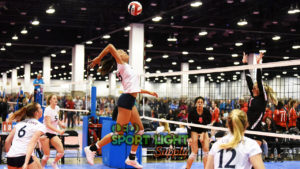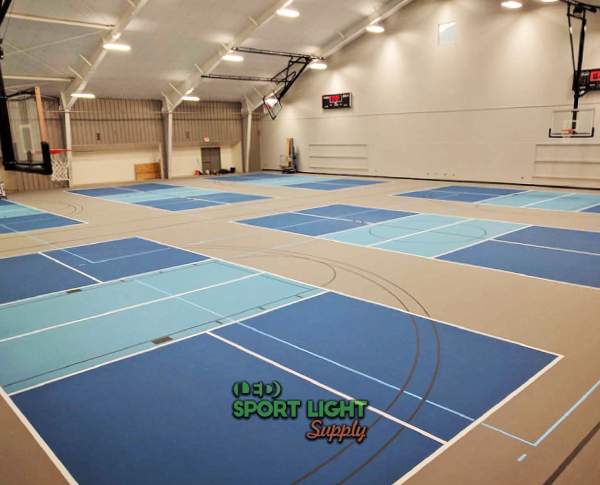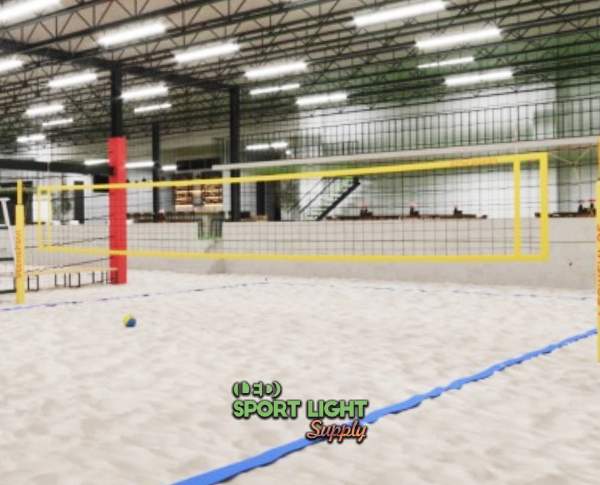
Whether for recreational facilities, schools, or professional arenas, lighting not only enhances gameplay visibility but also impacts operational expenses and overall experience for both players and spectators. Modern lighting technologies, such as LED systems, have emerged as an efficient choice compared to traditional lighting, offering greater energy savings and lower maintenance needs over time.
| Item | Description | Price (USD) |
|---|---|---|
| LED Lighting Fixtures | High-quality LED fixtures for volleyball court illumination | $10,000 – $30,000 |
| Traditional Lighting Fixtures | Metal halide or high-pressure sodium lamps | $5,000 – $15,000 |
| Installation Costs | Labor and materials for setting up lighting fixtures | $2,000 – $5,000 |
| Energy Consumption (LED) | Annual energy cost for a 2,000-watt LED system | ~$500 |
| Energy Consumption (Traditional) | Annual energy cost for a 4,000-watt traditional system | ~$1,000 |
| Maintenance (LED) | Annual maintenance cost for LED fixtures | ~$200 |
| Maintenance (Traditional) | Annual maintenance cost for traditional fixtures | $1,000 – $2,000 |
| Replacement Bulbs (Traditional) | Cost of replacement bulbs for traditional lighting systems | $500 – $1,000 |
| Total Cost of Ownership (10 Years, LED) | Total estimated cost including initial investment, energy, and maintenance for LED system | ~$12,000 |
| Total Cost of Ownership (10 Years, Traditional) | Total estimated cost including initial investment, energy, and maintenance for traditional system | ~$20,000 |
Table of Contents
Toggle When setting up a volleyball court, the initial cost of lighting installation can vary based on the chosen technology. Traditional lighting systems, such as metal halide and high-pressure sodium lamps, have been widely used and tend to have lower upfront costs. These systems offer effective illumination at a more affordable price, which can be advantageous for smaller budgets or temporary installations.
When setting up a volleyball court, the initial cost of lighting installation can vary based on the chosen technology. Traditional lighting systems, such as metal halide and high-pressure sodium lamps, have been widely used and tend to have lower upfront costs. These systems offer effective illumination at a more affordable price, which can be advantageous for smaller budgets or temporary installations.
In comparison, LED lighting systems come with a higher initial expense due to the technology’s sophistication and energy-saving capabilities. For a standard volleyball court, the cost of installing LED lighting typically ranges between $10,000 and $30,000, depending on factors such as the type of fixture, the number of units required, and the complexity of the installation. In contrast, traditional lighting options may cost between $5,000 and $15,000. This cost difference reflects the advanced features of LED lights, including improved energy efficiency, durability, and adaptability.
Although traditional lighting may seem cost-effective initially, the lower purchase price can be outweighed by the operating costs associated with high electricity consumption and frequent maintenance. The benefits of LED technology often justify the higher upfront investment due to long-term energy savings and minimal maintenance requirements. By understanding these long-term advantages, many facility managers and court owners opt for LED lighting to enhance both the quality of illumination and reduce future expenses.
One of the notable advantages of LED lighting is its reduced energy consumption compared to traditional lighting systems. LEDs typically consume up to 50% less energy than conventional lighting options, which results in significant savings on electricity bills for volleyball court owners. For example, a volleyball court with an LED lighting system that consumes approximately 2,000 watts will use around 4,000 kilowatt-hours per year. At an average electricity rate of $0.12 per kWh, this results in an annual energy cost of around $500.
By comparison, a traditional lighting system with similar output would require around 4,000 watts, resulting in an annual energy consumption of approximately 8,000 kilowatt-hours and an annual electricity cost of around $1,000. This difference in energy consumption translates directly into cost savings for LED systems, making them a cost-effective choice over time.
The energy efficiency of LED lights also offers environmental benefits, reducing the carbon footprint of the facility. For organizations or venues that prioritize sustainability, choosing LED lighting supports broader goals of energy conservation and environmental stewardship. Additionally, as energy prices fluctuate, the reduced energy consumption of LED lighting can provide greater cost predictability, insulating court operators from potential increases in electricity rates. For these reasons, LED systems offer both environmental and economic advantages, which enhance their value beyond the initial investment.
 One of the defining characteristics of LED lights is their durability. Unlike traditional bulbs, which may require frequent replacement, LEDs have an average lifespan of approximately 120,000 hours. This extended lifespan significantly reduces the frequency of replacements, which is especially beneficial for large-scale installations such as volleyball courts where fixture replacement can be labor-intensive and costly.
One of the defining characteristics of LED lights is their durability. Unlike traditional bulbs, which may require frequent replacement, LEDs have an average lifespan of approximately 120,000 hours. This extended lifespan significantly reduces the frequency of replacements, which is especially beneficial for large-scale installations such as volleyball courts where fixture replacement can be labor-intensive and costly.
In contrast, traditional lighting options like metal halide and high-pressure sodium lamps have much shorter lifespans, typically lasting between 2,000 to 5,000 hours before requiring replacement. This shorter operational life can lead to increased maintenance needs and higher costs over time. For facilities with continuous or heavy usage, the durability of LED lights offers a clear advantage, ensuring consistent illumination and reducing the logistical challenges associated with frequent replacements.
The lower maintenance requirements of LED lights also translate into financial savings. Traditional lighting systems may require annual maintenance budgets ranging from $1,000 to $2,000 to cover costs associated with replacements and repairs. In contrast, LED lighting systems often require maintenance expenses of less than $200 annually, due to their durability and reduced failure rates. This significant difference in maintenance costs can help offset the higher initial cost of LED lighting within the first few years of operation.
For court operators, reduced maintenance needs mean fewer disruptions to gameplay and fewer hours spent on fixture upkeep, allowing staff to focus on other priorities. By reducing the frequency of maintenance interventions, LED lighting improves overall efficiency and minimizes operating costs, making it a preferable option for facilities looking to streamline their operational budgets.
When evaluating the total cost of ownership for a lighting system, considering both initial and long-term expenses is essential to understanding the full financial impact. Over a 10-year period, LED lighting systems often prove more economical than traditional lighting options. For instance, the total operating cost of a traditional lighting system over a decade may amount to around $20,000, factoring in both energy and maintenance expenses.
In contrast, an LED lighting system’s total cost over the same period is estimated at around $12,000 due to lower energy consumption and minimal maintenance needs. This represents a potential savings of $8,000 over a decade, which is substantial for facility operators looking to maximize their budgets and reduce operational costs.
For facilities planning long-term budgets, the cost-effectiveness of LED lighting offers a dependable solution. The predictable operational expenses associated with LED systems help facility managers more accurately forecast their financial needs over time. By opting for LED lighting, volleyball court operators can reduce unexpected maintenance costs, control energy expenses, and plan for other facility upgrades or improvements. This stability in operational costs is a compelling reason why many choose LEDs despite their higher initial investment.
Beyond financial considerations, lighting plays a critical role in the quality of play and overall spectator experience on a volleyball court. LED lighting offers a clear advantage in terms of visibility and color accuracy, creating a well-lit environment that enhances the gameplay experience. This level of illumination allows players to better track the ball, anticipate movements, and react quickly, which can contribute to a safer and more enjoyable game.
In addition, LEDs are designed to reduce glare, making them ideal for both indoor and outdoor courts. Traditional lighting systems, in contrast, can produce harsher light, which may lead to visual discomfort or difficulty for players and spectators. By providing a clearer, more comfortable lighting environment, LED systems support an improved experience for everyone involved.
High-quality lighting can also elevate a facility’s appeal for hosting tournaments and events. For venues that rely on rentals, events, or tournament bookings as revenue sources, LED lighting provides a competitive edge. Well-illuminated courts create an inviting atmosphere for players and spectators alike, making it more likely that organizers will select the venue for events. Improved lighting quality may also enhance the appearance of televised or recorded events, potentially attracting higher-profile tournaments and increasing revenue opportunities for the facility.
Investing in volleyball court lighting involves weighing upfront expenses against long-term benefits. While traditional lighting systems offer a lower initial cost, their high energy consumption and frequent maintenance needs can drive up total costs over time. LED lighting, although initially more expensive, presents a cost-effective option due to its energy efficiency, durability, and minimal maintenance requirements. For volleyball court operators, choosing LED lighting not only reduces operational expenses but also enhances the playing experience, supports environmental sustainability, and increases the venue’s attractiveness for events. By considering both immediate and long-term factors, operators can make an informed choice that supports the facility’s goals and ensures a high-quality experience for all users.
Drop us a line to receive a free lighting design